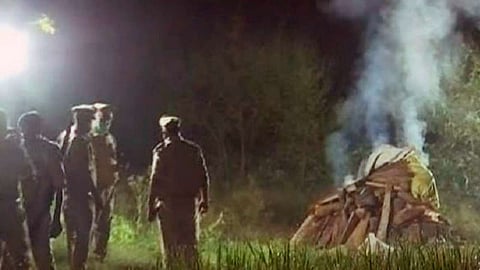

The Hathras rape case has brought to the forefront caste-based sexual violence by upper caste men on Dalit women. It has cracked open the question on the intersectionality of caste and patriarchy. PROF. PARINITHA SHETTY writes on the multiple ways that caste and patriarchy have unfolded in the state and society's approach in this case.
———-
RAPE is violence through which power stamps its mark on the bodies of those who are most vulnerable.
Rape is the exercise of brutality by men on women.
It is an instrument that power deploys to display its might in a brutal spectacle of violation and violence.
Rape has been the weapon of those who are privileged by the hierarchies of kinship, caste, class, religion, gender, and race.
Rape is the means through which a political system, which exercises arbitrary despotic power, keeps its regime of terror in place.
Rape generates many cultural messages.
A patriarchal society valorises female chastity and imposes the burden of guarding and maintaining it on women. The chastity of women is conflated with the honour of the family, the purity of the caste, the sanctity of the family and the civilization of a nation.
Rape draws and maintains the boundaries of caste, class, religion, race and family by mapping it on the bodies of women and regulating the means of access to their bodies.
“To understand the violence perpetrated in Hathras only as rape is to erase the whole range of brutalities and privileges that intersect in that single act of brutalizing and dismantling a Dalit girl's body.
Rape is an act that violates this boundary. It is an act that displays the power of the social group to which the perpetrator of rape belongs.
The raped body becomes the site on which such displays of power can be enacted and marked out.
Rape is located at the extreme end of the spectrum of violence that is normalized in a hierarchically structured inegalitarian society that promotes inequality between people..
When a Dalit woman is raped by upper caste men and the state machinery uses all its instruments of power to efface the egregiously brutal traces of the rape. A whole range of privileges and powers work in collusion with each other in a brazen disregard of law, morality, and rules of social coexistence.
To understand the violence perpetrated in Hathras only as rape is to erase the whole range of brutalities and privileges that intersect in that single act of brutalizing and dismantling a Dalit girl's body.
The inaccessibility of immediate and expert medical treatment for the girl reveals the institutionally organized structures of power. The structure ensures that those who are socially vulnerable and disempowered are denied access to social resources that should accrue to every citizen in a democracy.
“The brother's futile struggle for their sister's body is a public display of the routine effeminisation of Dalit men in their daily interactions with the many orders of power in a caste society.
The attempts by the district administration and the police to prevent the official and legal recording of the brutal act as rape reveals the collusion between caste privilege and the functionaries of the state.
The reluctance of the mother of the girl to initially record the violation of her daughter's body as rape as 'she wanted to save her daughter's dignity', reveals the terrible stranglehold of patriarchal values. The lives of women have internalised these values that furthers their own oppression.
The brother's futile struggle for their sister's body is a public display of the routine effeminisation of Dalit men in their daily interactions with the many orders of power in a caste society. The denial of death rituals to her family members is the denial of their belonging to the fundamental social unit and to the rights that accrue to such belonging.
And for all of us who were confronted with the helpless grief of the mother, it is a searing vision of the inhuman inequalities of the world in which we live. It is a vision of the entrenched hypocrisies that valorise the mother as the most ideal manifestation of the feminine and at the same time denies a Dalit mother the closure of death rituals to her daughter.
It is a vision of a society that forces on a powerless Dalit mother the blinding sight of the naked raped body of her daughter thrown like litter in a field of millet.
It is the vision of a society that denies a Dalit mother the comfort of looking and touching the mangled corpse of her daughter for the last time.
It is a vision of a society that denies a Dalit family the paltry closure of cremation to the brutal murder of a daughter and sister.
It is a vision of how a social and political system institutes and legitimises structures and institutions that marginalise innumerable lives and make them unlivable and unseeable.
(Professor Parinitha Shetty teaches English in the Department of English, Mangalore University, Karnataka. Views are personal.)